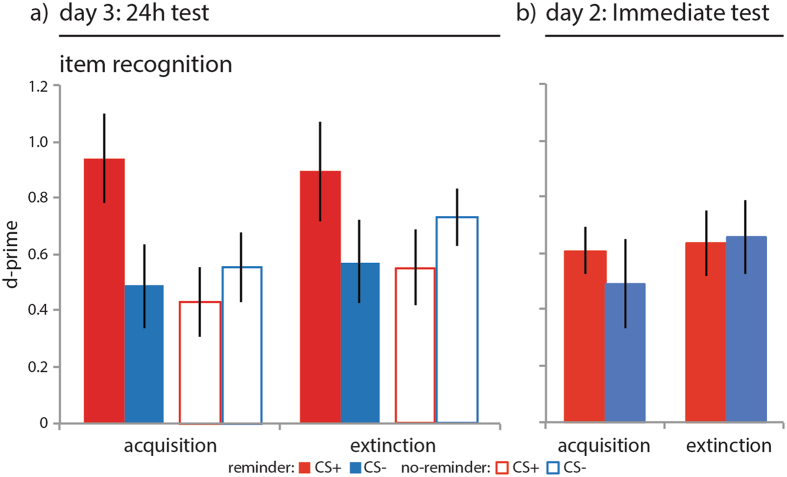Figure 2.
Results item recognition memory. An isolated reminder resulted in better item recognition specific to items from the CS+ category after 24 h but not immediately. (a) Reminder group (solid bars, N = 18), no-reminder group (open bars, N = 20), CS+ (red), CS− (blue), acquisition = items that were presented during acquisition, extinction = items that were presented during extinction, error bars reflect SEM. Across both groups participants were able to discriminate old from new items as revealed by one sample t-tests on d-prime scores (CS+: t(37) = 6.335, p < 0.001; 0.6711 ± 0.1059; CS−: t(37) = 5.483, p < 0.001; 0.5216 ± 0.0951). Follow-up independent samples t-test on difference scores ([CS+ acquisition + CS+ extinction] − [CS− acquisition + CS− extinction]) revealed greater differential item memory in the reminder group compared to the no-reminder group (t(36) = −3.050, p = 0.004; no-reminder: −0.2995 ± 0.2720; reminder: 0.7721 ± 0.2139). Follow-up paired samples T-test on the average d-prime scores across acquisition and extinction for CS+ and CS− items revealed better memory for CS+ items than CS− items in the reminder group (t(17) = 3.610, p = 0.002; CS+: 0.9158 ± 0.1207; CS−: 0.5298, ±0.1432) but no difference in the no-reminder group (t(19) = −1.101, p = 0.285; CS+: 0.4908 ± 0.1167; CS−: 0.6405 ± 0.0827). Planned t-test revealed better memory for CS+ than CS− items from acquisition (t(17) = 3.691, p = 0.002; CS+: 0.9386 ± 0.1570; CS−: 0.4868, ±0.1510) and extinction (t(17) = 2.571, p = 0.020; CS+: 0.8930 ± 0.1764; CS−: 0.5728, ± 0.1458) in the reminder but not the no-reminder group (p > 0.2). (b) For the reminder immediate memory test group (right panel, solid bars, N = 16) follow-up paired samples t-test on the average d-prime scores across acquisition and extinction for CS+ and CS− items revealed no difference in recognition memory (t(15) = 0.312, p = 0.759; CS+: 0.6855 ± 0.0611; CS−: 0.6458 ± 0.1314), and planned comparisons revealed no difference between CS+ and CS− items from acquisition and extinction (Ps > 0.6).

